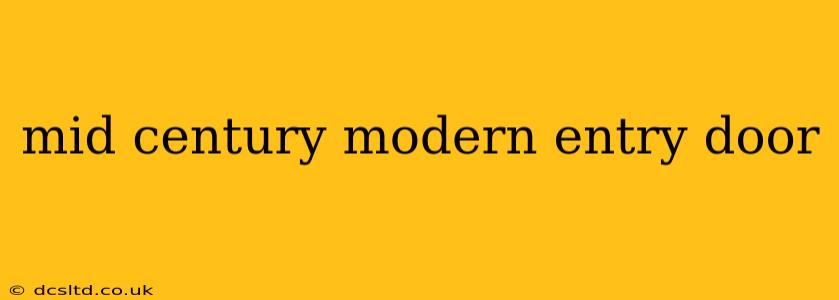The entry door is the first impression of your home, a statement piece that sets the tone for the entire interior. For those embracing the timeless elegance of mid-century modern design, choosing the right entry door is crucial. This guide explores the key elements of mid-century modern entry doors, helping you select the perfect door to enhance your home's curb appeal and reflect your unique style.
What Defines a Mid-Century Modern Entry Door?
Mid-century modern design, flourishing from roughly the 1930s to the 1960s, emphasizes clean lines, functional simplicity, and a connection between indoor and outdoor spaces. This translates to entry doors characterized by:
- Geometric Shapes: Think clean rectangles, sometimes with subtle variations like slightly rounded corners or recessed panels. Avoid overly ornate or fussy details.
- Simple Hardware: Sleek, minimalist door handles and knobs, often in brushed metal finishes like chrome, brass, or nickel, are key. Avoid elaborate designs or excessive ornamentation.
- Natural Materials: Wood (especially teak, walnut, and mahogany), glass, and metal are favored materials. The focus is on showcasing the natural beauty of the material, rather than heavily concealing it.
- Emphasis on Functionality: The door's design should prioritize ease of use and durability. Think solid construction and smooth operation.
- Color Palette: Neutral colors like beige, gray, black, and various shades of wood stain are prevalent. Bold colors can be used sparingly, often as an accent on a smaller detail.
What Materials are Commonly Used in Mid-Century Modern Entry Doors?
Wood: Solid wood doors remain a popular choice, offering durability, warmth, and a classic appeal. Popular wood types for mid-century modern doors include:
- Teak: Known for its rich color, durability, and natural resistance to weather.
- Walnut: A dark, luxurious wood that adds sophistication to any home.
- Mahogany: Offers a deep, reddish hue and excellent durability.
Glass: Large panels of glass, often framed in metal, are a signature element of mid-century modern design. This allows for ample natural light and creates a visual connection between the interior and exterior.
Metal: Steel and aluminum are sometimes used, especially for framing glass panels or creating a modern, industrial aesthetic. These materials offer durability and low maintenance.
What are Some Popular Mid-Century Modern Entry Door Styles?
Several styles capture the essence of mid-century modern design:
- Flush Doors: Simple, flat panel doors with minimal detailing.
- Panel Doors: Doors with recessed panels, often arranged in geometric patterns. The panels can be solid wood or glass.
- Glass and Metal Doors: A striking combination of materials, often featuring large glass panels within a sleek metal frame.
How Much Does a Mid-Century Modern Entry Door Cost?
The cost of a mid-century modern entry door varies greatly depending on the materials, size, design, and any custom features. Expect to pay anywhere from a few hundred dollars for a more basic door to several thousand dollars for a high-end, custom-made door.
Where Can I Find Mid-Century Modern Entry Doors?
You can find mid-century modern entry doors through various sources:
- Home Improvement Stores: Larger retailers often carry a selection of pre-made doors.
- Specialty Door Suppliers: These suppliers specialize in custom-made doors and can offer a wider range of styles and materials.
- Antique Shops and Salvage Yards: You might find vintage doors that can be restored and repurposed.
- Online Retailers: Many online retailers offer a diverse selection of entry doors.
What are the Pros and Cons of Choosing a Mid-Century Modern Entry Door?
Pros:
- Timeless Style: Mid-century modern design remains popular, meaning your door will remain stylish for years to come.
- Clean Lines and Simplicity: The minimalist aesthetic creates a sense of calm and sophistication.
- Natural Materials: The use of natural materials adds warmth and character to your home.
Cons:
- Cost: High-quality mid-century modern doors can be expensive.
- Maintenance: Wood doors require regular maintenance to protect them from the elements.
- Limited Availability: Finding the perfect mid-century modern door might require some searching.
By carefully considering these factors, you can choose a mid-century modern entry door that perfectly complements your home's architecture and reflects your personal style. Remember to prioritize quality materials, craftsmanship, and a design that speaks to your aesthetic preferences.
